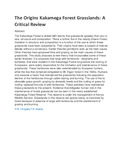The Origins Kakamega Forest Grasslands: A Critical Revie
Abstract
The Kakamega Forest is dotted with twenty five grasslands (glades) that vary in size, structure and composition. There a further five in the nearby Kisere Forest. Variation in structure and composition is a function of the use to which these grasslands have been subjected to. Their origins have been a subject of intense debate without a consensus. Earlier theories pointed to soils as the main cause. Other theories have proposed fires and grazing as the main causes of these grasslands. This study proposes a new theory that incorporates some of these earlier theories. It is proposes that large wild herbivores - elephants and buffaloes, that were resident in the Kakamega Forest long before the coming of Europeans, were solely responsible for the formation and maintenance of these grasslands. These herbivores were later exterminated by European hunters, while the few that remained emigrated to Mt. Elgon forest in the 1920s. Humans only became a factor that maintained the grasslands following the population decline of the herbivores through cattle rearing and burning. The use of fire to stimulate grass growth, grazing by domestic herds and the cutting of grass for roofing replaced the role of wild herbivores. These activities have maintained these grasslands to the present. Evidence that mitigates human role in the maintenance of forest grasslands can be seen in the newly established Kakamega Forest Reserve. This reserve is under the management of Kenya Wildlife Service. Grasslands in this reserve are quickly being re-colonized by forest because of absence of large wild herbivores and the abolishment of grazing and burning.
URI
https://doi.org/10.1080/09709274.2009.11906201https://www.tandfonline.com/doi/abs/10.1080/09709274.2009.11906201
http://ir-library.mmust.ac.ke:8080/xmlui/handle/123456789/2186
Collections
- Gold Collection [1026]

